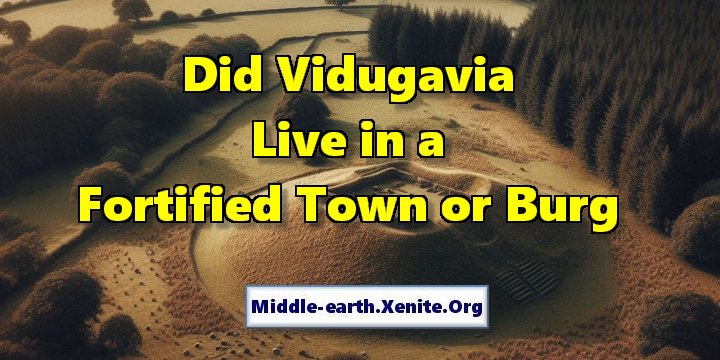
Q: Did Vidugavia Live in a Fortified Town or Burg?
ANSWER: Vidugavia is the most ancient name Tolkien gave for any of the Northmen in Middle-earth, and it is a Latinized form of ancient Gothic Widu-gauja, which Christopher Tolkien translates as “wood (forest) dweller” although it might be better to use “denizen” or “citizen” to translate “gauja” (this is a linguistic matter that is a bit above my head but there are subtle variations in meaning depending on context).
Vidugavia’s people had created the East Bight in southern Mirkwood, the great indentation in the otherwise thick forest, by cutting down an immense number of trees. The original width of the forest is never stated but presumably there were a LOT of Northmen living in the area. Furthermore, Tolkien says that they frequently fought among themselves (as well as with other people, the Easterlings).
According to the story given in “Appendix A” in The Lord of the Rings, Vidugavia “called himself King of Rhovanian”, meaning he had claimed an authority over all the other princes of the region. Tolkien is careful to say that Vidugavia claims the title of king but is not necessarily acclaimed or acknowledged so by all the other princes — and perhaps in doing so is implying that Vidugavia’s title is self-styled. Generally speaking, any “self-styled” title is assumed without justification. That is, it is not given on the basis of inheritance or popular acclaim. Hence, Vidugavia was almost certainly envisioned by Tolkien as a warrior and a conqueror (of his neighboring princes). He may have (in Tolkien’s thoughts) played a role in Northman politics similar to that of Clovis I in Frankish history. Clovis I did not simply unite the Franks and some other Germanic tribes living in the former Gaul — he wiped out all the nearby rival Frankish kings, and he is said by Geoffrey of Tours to have regretted having no more kinsmen (to kill) after he had united the Frankish lands.
Assuming these comparisons and inferences are acceptable, it follows that Vidugavia and his people must have lived in fortified burgs (the actual Gothic cognate for Old English burgh was baurgs). The number, names, and locations of these fortified settlements would have been known to at least some of Gondor’s scholars in their day but they probably were forgotten by the Éothéod, who only had Framsburg in their far northern land of exile. Hence, Tolkien devotes no effort to explaining the “lost details” of the most ancient history of the Northmen for the reader. The “facts” — if they still existed — were buried somewhere deep in Minas Tirith’s libraries and probably never uncovered by the Hobbits of the Shire (who were responsible for conveying the history of Middle-earth to the present generation).
It should be noted that there is no known Gothic cognate for Old English byht (Bight), which is an old word for “bay”, an inlet or bend in a shoreline where a sea digs deep into the landscape. Hence, the “East Bight” is named only in modern English — presumably reflecting a Westron name that may not have any relation to the original Northman name for the region. In fact, many Tolkien scholars translate Rhovanion as Wilderland although I have proposed an alternate translation. The closest known Gothic word would be biujan, which means “to bend” (or “curve”). The word buga (“bow”) is thought to derive from that root.
If you are writing fan fiction or role-playing adventures it would make sense to devise a nomenclature for a densely settled land in the East Bight, perhaps using Gothic-style names. I have come across a reference to a Widu-burh which seems to be an attempt to devise such a name. So far as I know that is a completely non-canonical name (and I suspect a more appropriate construction might be Vidu-Burgus although I don’t know how Tolkien would have “Latinized” baurgs).
# # #
Have you read our other Tolkien and Middle-earth Questions and Answers articles?
